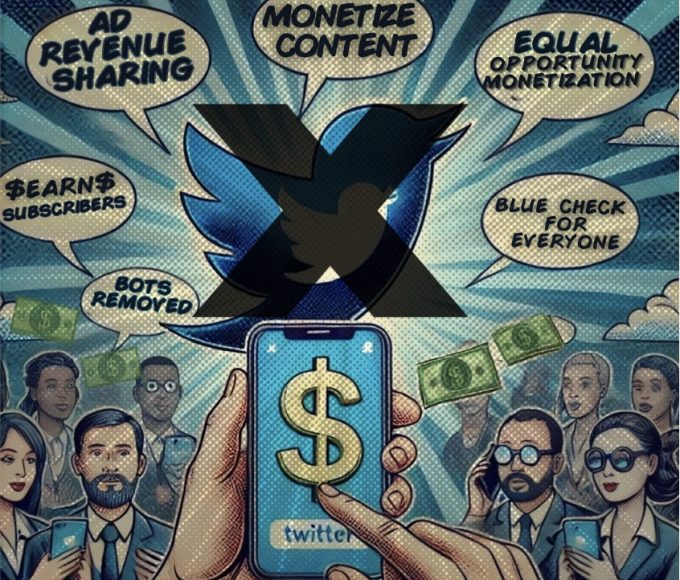
Web Design Trends for 2024: Stay Ahead of the Curve
As we move further into 2024, web design continues to evolve, driven by technological advancements and changing user preferences.

Since Elon Musk acquired Twitter in late 2022, the social media platform has undergone a series of transformative changes aimed at making it a more inclusive and profitable space for all users. Musk’s vision for Twitter marks a significant departure from the previous management under Jack Dorsey, where monetization and verification were often out of reach for the average user due to high costs and stringent requirements.
One of the most significant changes under Elon Musk’s leadership has been the introduction of new monetization features that empower content creators. Musk has rolled out a revenue-sharing model that allows users to earn money from advertisements displayed in their reply threads. This initiative ensures that creators can benefit financially from their engagement on the platform, providing a new stream of income that was previously inaccessible.
In addition, Musk has introduced a subscription feature, enabling users to monetize various forms of content, including text, images, and videos. Creators can set monthly subscription fees, and Twitter allows them to retain 97% of the revenue up to $50,000 in lifetime earnings. After reaching this threshold, the revenue share drops to 80%, still providing a substantial incentive for creators to engage with their followers. This model contrasts sharply with the previous approach, where monetization opportunities were limited and often reserved for high-profile users.
Under Jack Dorsey’s tenure, obtaining a blue checkmark on Twitter was a challenging and expensive process, often seen as a status symbol reserved for celebrities and large corporations. The high costs and unclear criteria for verification made it difficult for everyday users to achieve this status, limiting their visibility and credibility on the platform.
Elon Musk has democratized the verification process through the introduction of Twitter Blue, a subscription service that offers verification at a more affordable rate. This change has lowered the barriers to entry, allowing more users to access the benefits of a verified status, such as increased visibility and enhanced credibility on the platform. By making verification more accessible, Musk has ensured that a broader range of voices can be heard and recognized on Twitter.
Musk’s vision for Twitter extends beyond monetization and verification. He has emphasized the importance of using artificial intelligence (AI) to combat misinformation and promote genuine voices on the platform. The implementation of AI tools aims to detect and mitigate manipulation of public opinion, creating a safer and more authentic online environment for all users.
Moreover, Musk’s strategic decisions, such as partnering with payment processors like Stripe, have streamlined the payout process for creators, making it easier for them to receive their earnings efficiently and securely. These changes support the platform’s goal of fostering a diverse and vibrant online community by enabling more users to benefit from their presence on Twitter.
The transformations under Elon Musk have redefined Twitter as an equal opportunity platform where content creators, regardless of their following size or financial status, can thrive. By lowering the costs associated with verification and providing multiple avenues for monetization, Musk has made it possible for the average user to benefit from their engagement on the platform.
Elon Musk’s tenure at Twitter has marked a significant departure from the past, where high costs and exclusive policies limited the potential of many users. Today, Twitter stands as a more inclusive and equitable platform, offering monetization opportunities and verification access to a broader audience. These changes have not only democratized the platform but also fostered a more diverse and vibrant online community, aligning with Musk’s vision of a more open and accessible social media environment.
For more detailed insights on Elon Musk’s changes to Twitter, you can explore the original sources from Cointelegraph and Hindustan Times
Business insights and articles written by our team of world-class professionals

In today’s fast-paced digital world, the importance of branding cannot be overstated. Whether you’re a startup looking to establish your identity or an established company considering a rebrand, branding and rebranding in 2024 are more crucial than ever. With customer expectations evolving and the market landscape shifting, it’s essential to stay ahead of trends and ensure that your brand resonates with your target audience.
In this article, we’ll explore the importance of branding, the rebranding process, and the key trends shaping brand strategies in 2024.
Branding isn’t just about a logo or a catchy tagline—it’s the essence of your company. It communicates who you are, what you stand for, and how you’re different from your competitors. Here’s why branding is crucial in 2024:
Rebranding is not a decision to be taken lightly, but it’s often necessary as businesses evolve. Here are some key reasons why companies choose to rebrand:
The following trends are shaping the branding landscape in 2024 and beyond:
Consumers are increasingly aligning themselves with brands that share their values. In 2024, sustainability and social responsibility will continue to be driving forces behind brand loyalty. Customers expect brands to take a stand on environmental and social issues, so your brand needs to clearly communicate its purpose and values.
In terms of design, less is more. Brands are moving towards minimalist logos and simple designs that are both versatile and memorable. This trend is particularly important for brands looking to modernize or refresh their image without a complete overhaul.
Customers in 2024 expect personalized experiences from the brands they engage with. A successful branding strategy will incorporate personalized messaging, customer data insights, and tailored experiences. Rebranding efforts should consider the customer journey and how the new brand can better meet customer needs.
With the rise of online shopping and social media dominance, brands must prioritize their digital presence. A strong digital-first branding strategy is essential, from your website design to social media branding and e-commerce experience. This means ensuring that your brand looks and feels consistent across all digital platforms, including mobile devices.
People connect with people, not faceless corporations. Brands that show their human side by showcasing the people behind the brand, engaging in authentic conversations, and building emotional connections will thrive. Humanized branding allows companies to build deeper relationships with their customers, leading to increased loyalty.
Artificial intelligence (AI) and automation are changing how brands interact with customers. In 2024, more brands will integrate AI-driven solutions into their customer service, marketing, and branding strategies. Chatbots, personalized recommendations, and AI-generated content are just a few examples of how technology is influencing branding.
If you’re considering rebranding in 2024, here are some key steps to ensure success:
Start by analyzing your existing brand. What’s working? What’s not? Gather feedback from customers, employees, and stakeholders to identify areas for improvement. Understand why you’re rebranding and what you hope to achieve.
Before diving into the design phase, define your brand’s new identity. This includes your brand mission, values, personality, and voice. Your brand identity should reflect who you are as a company and resonate with your target audience.
A successful rebrand requires more than just a new logo. Your rebranding strategy should encompass everything from messaging and design to marketing campaigns and customer communication. Ensure that your new brand is consistently represented across all touchpoints, from your website and social media to packaging and advertisements.
Rebranding is a company-wide effort. Engage your team early in the process and keep them informed. Their buy-in is crucial to successfully implementing the new brand. Training may be necessary to ensure employees understand the new brand and how to communicate it.
A rebrand can confuse loyal customers if not communicated effectively. Use email campaigns, social media, and PR efforts to announce your rebrand. Explain why you’re rebranding and how it benefits them. Transparency builds trust.
As we move deeper into the digital age, branding will continue to evolve. Brands that stay relevant by embracing sustainability, personalization, technology, and a customer-first approach will lead the way in 2024. Whether you’re building a brand from scratch or considering a rebrand, the key is to create an authentic, meaningful connection with your audience.
By keeping these trends and strategies in mind, businesses can stay ahead of the curve and build a brand that resonates with their customers in 2024. Rebranding or refining your existing brand isn’t just about keeping up with trends—it’s about creating lasting, meaningful relationships with your audience.
In 2024, the landscape of branding and rebranding continues to shift, driven by technology, customer expectations, and societal values. Whether you’re refreshing an outdated brand or launching a new one, your strategy must center around authenticity, customer-centricity, and digital adaptability. Remember, a brand is more than just a logo—it’s the heartbeat of your business.

As we move further into 2024, web design continues to evolve, driven by technological advancements and changing user preferences.

Rebranding your business can breathe new life into your company, attract new customers, and reposition you in the market.

Lorem ipsum dolor sit amet, consectetur adipiscing elit, sed do eiusmod tempor